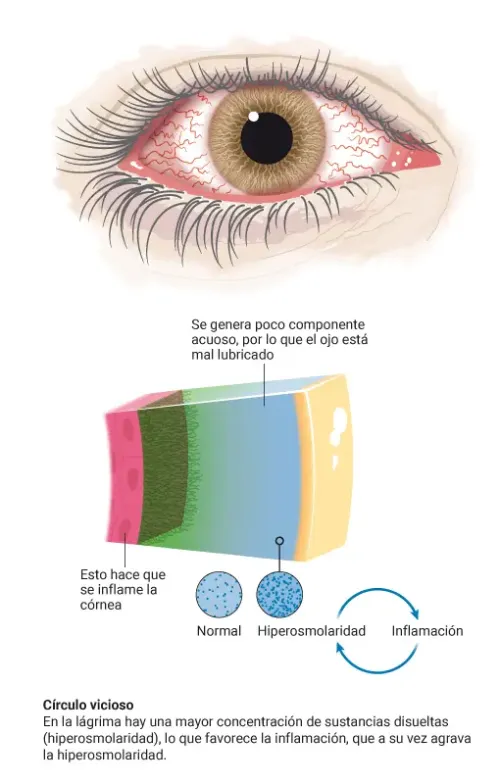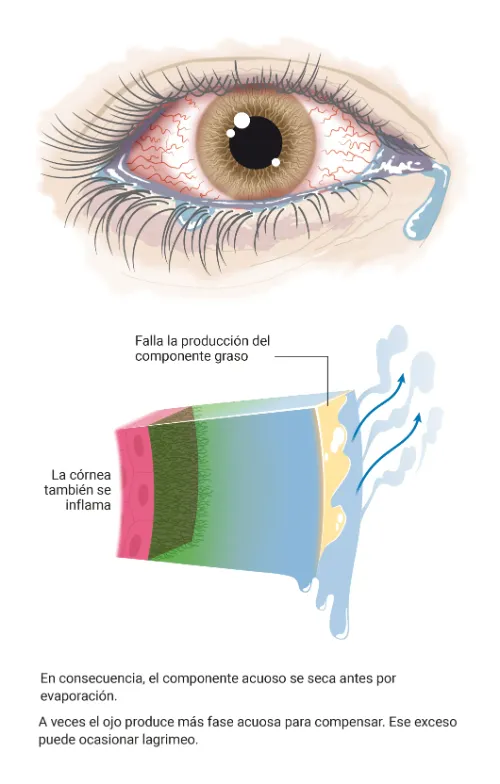Dry Eye
"At the Clinica, we study individually the best treatment for our patients with dry eye syndrome and blepharitis. For this reason, we put at your disposal the best human and technological equipment".
DR. CRISTINA ABASCAL
SPECIALIST. OPHTHALMOLOGY DEPARTMENT
What is dry eye?
Dry eye or dry eye surface is a very common ophthalmological problem that can be favored or caused by various factors (autoimmune, environmental, hormonal, toxic, etc.)
Due to the multifactorial origin of this disease it is very important to try to identify in each case which factors are most influencing the patient's symptomatology, in order to be able to carry out the most individualized treatment possible.
In many cases it is a long-lasting disease and it is often not possible to make the symptoms caused by this disease disappear completely, so the objective of its treatment is to reduce the intensity of our patients' symptoms as much as possible.

Types of dry eye
What are the symptoms of dry eye?
Among the most common symptoms that can appear in this disease are the following: foreign body or gritty sensation in the eyes, eye itching and stinging, "eye pins", heaviness of the eyelids, "visual fatigue", photophobia or fluctuating blurred vision. Even in some cases there may be a need to keep your eyes closed.
There may also be an apparently paradoxical increase in tearing, which is usually due to the fact that as the eye surface does not enjoy the constant hydration it needs, in an attempt to compensate for this deficiency, which moreover does not achieve its objective, a reflex hyper-tearing occurs.
Most common symptoms:
- Foreign body sensation.
- Tearing.
- Fluctuating blurred vision.
- Heaviness of the eyelids.
Do you have any of these symptoms?
You may have a dry eye problem
How is dry eye diagnosed?
Schirmer Test: Measures the amount of tears produced by the eyes. It consists of placing a strip of filter paper on the lower eyelid and measuring the amount of tears absorbed in a given period of time.
Tear film breakup time: Evaluates the stability of the tear on the ocular surface. A special dye solution is used and placed in the eye and the time it takes for a dry spot to appear in the tear film is observed.
Evaluation of the eyelids and Meibomian glands: The eyelids are examined for signs of inflammation or dysfunction of the Meibomian glands, which can affect tear quality.
We have the appropriate technology that allows us to try to make an individualized diagnosis in each patient.
We use for diagnosis the Keratograph 5M® which is a placid disc topographer with white and infrared illumination. It evaluates 22,000 points on the surface, which provides very precise and detailed information on the state of the ocular surface and the tear film.
What are the causes of dry eye?
There are many causes and risk factors for dry eye.
Some of them are:
- Advanced age.
- Menopause.
- Environmental factors.
- Poor nutrition.
- Autoimmune diseases.
- Medication side effects.
- Ocular traumas.
- Use of contact lenses.
How is dry eye treated?
We have the latest diagnostic and therapeutic advances for dry eyes.
In all cases, the "dry eye syndrome" involves an inadequate wetting and lubrication of the eye surface, which causes the appearance of symptoms that can sometimes be very intense, annoying, even limiting the usual activity of the person who suffers from it and affecting their quality of life. Therefore, it will be necessary to supplement the natural hydration provided by our tears, with the contribution of artificial tears and other gels or ointments that keep the ocular surface adequately lubricated, day and night. It is desirable that the tear supplements used do not contain preservatives.
Also, instability of the tear film and inflammation of the ocular surface play an important etiological role in the development of this disease. The dysfunction of the Meibomian glands of the eyelids is at the base of most cases in which we find a "tear fragility", and therefore an excessively fast evaporation of the tear.
For this reason, in many patients it is necessary to indicate various physical treatments that improve the "quality" of our tear or that allow for a longer permanence of the tear, both natural and artificial, in contact with the ocular surface. And, of course, anti-inflammatory, immunomodulatory or blood derivative treatments (autologous serum, PRP, PRGF) must be introduced in order to control the inflammatory component present in many eyes affected by dryness. There are also sensitivity modulators that do not completely anesthetize the eye.
Finally, in some patients the chronicity of the symptoms caused by this disease can lead to the appearance of so-called "neuropathic pain", which is a pain produced by chronic stimulation of the sensitive ends of the eye surface and which can remain even when the signs of dryness of the eye surface have decreased significantly thanks to the treatment. It is necessary, in some exceptional cases, the establishment of a treatment by the specialists of the Pain Area.
From the Ophthalmology Department of the Clinic, we work in close collaboration with other departments such as Rheumatology, Hematology, Hospital Pharmacy or the Pain Area, to try to provide the most personalized medical assistance possible.
Intense Pulsed Light (IPL) for Dry Eye
It is a non-invasive therapeutic technique that uses high-intensity pulses of light to stimulate the tear-producing glands in the eyes, promoting the production of better quality tears and helping to alleviate dry eye symptoms.
In addition, pulsed light can also improve blood circulation around the eyes, contributing to better overall eye health.
Where do we treat it?
IN NAVARRA AND MADRID
The Department of Ophthalmology
of the Clínica Universidad de Navarra
Equipped with the latest technology, the Department of Ophthalmology has the necessary equipment, both technical and human, to offer comprehensive and specific assistance to each patient.
We are one of the few centers that have a microsurgery laboratory for the improvement of clinical practice.
Organized in specialized units
- Cornea and eye surface
- Retina
- General Ophthalmology
- Refraction defects
- Oculoplastic
- Pediatric ophthalmology

Why at the Clinica?
- More than 30 years of experience.
- Experts in the diagnosis and treatment of ocular pathologies.
- With the security and guarantee of a prestigious hospital.




















